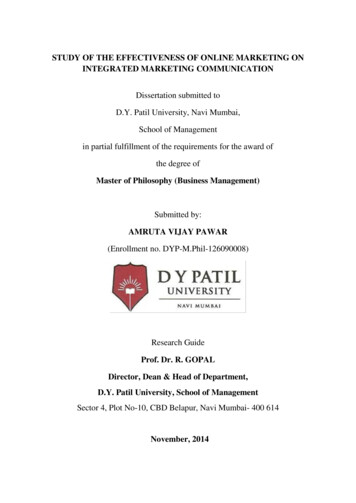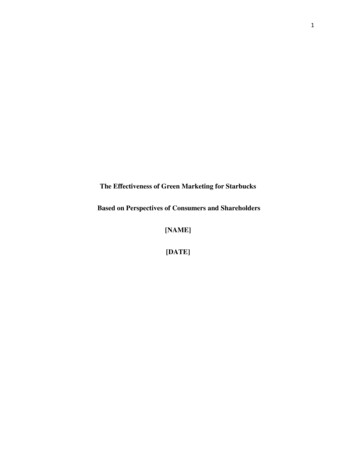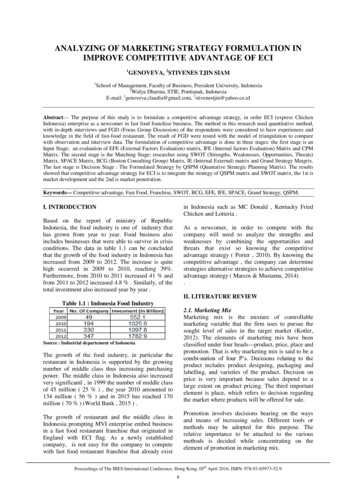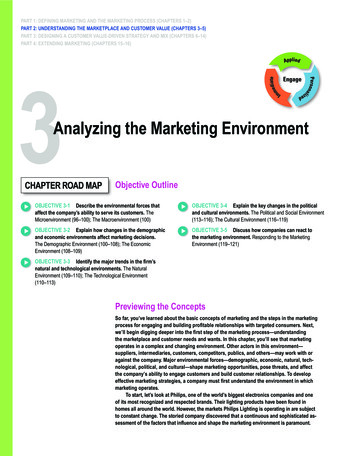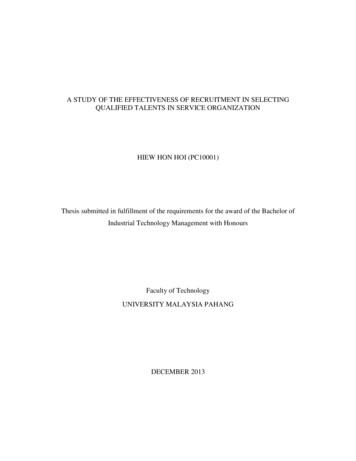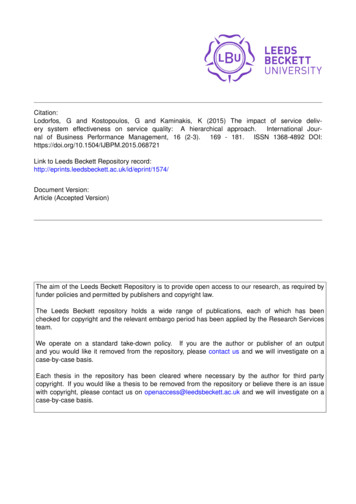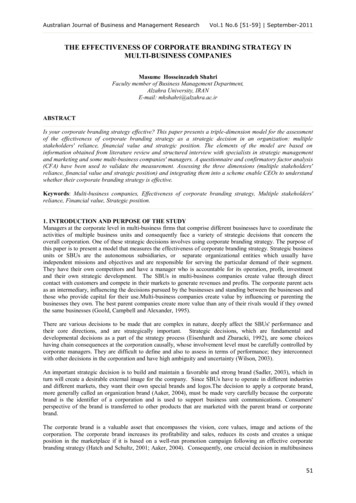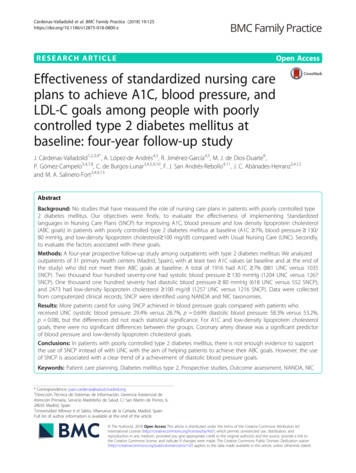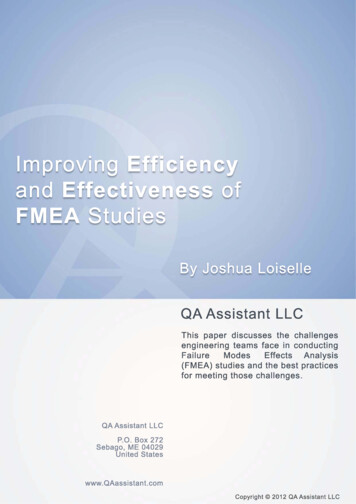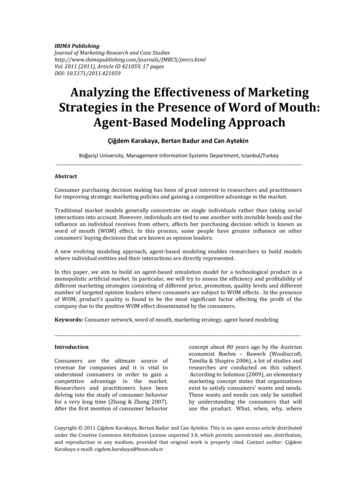
Transcription
IBIMA PublishingJournal of Marketing Research and Case CS/jmrcs.htmlVol. 2011 (2011), Article ID 421059, 17 pagesDOI: 10.5171/2011.421059Analyzing the Effectiveness of MarketingStrategies in the Presence of Word of Mouth:Agent-Based Modeling ApproachÇiğdem Karakaya, Bertan Badur and Can AytekinBoğaziçi University, Management Information Systems Department, Istanbul/TurkeyAbstractConsumer purchasing decision making has been of great interest to researchers and practitionersfor improving strategic marketing policies and gaining a competitive advantage in the market.Traditional market models generally concentrate on single individuals rather than taking socialinteractions into account. However, individuals are tied to one another with invisible bonds and theinfluence an individual receives from others, affects her purchasing decision which is known asword of mouth (WOM) effect. In this process, some people have greater influence on otherconsumers’ buying decisions that are known as opinion leaders.A new evolving modeling approach, agent-based modeling enables researchers to build modelswhere individual entities and their interactions are directly represented.In this paper, we aim to build an agent-based simulation model for a technological product in amonopolistic artificial market. In particular, we will try to assess the efficiency and profitability ofdifferent marketing strategies consisting of different price, promotion, quality levels and differentnumber of targeted opinion leaders where consumers are subject to WOM effects . In the presenceof WOM, product’s quality is found to be the most significant factor affecting the profit of thecompany due to the positive WOM effect disseminated by the consumers.Keywords: Consumer network, word of mouth, marketing strategy, agent based modelingIntroductionConsumers are the ultimate source ofrevenue for companies and it is vital tounderstand consumers in order to gain acompetitive advantage in the market.Researchers and practitioners have beendelving into the study of consumer behaviorfor a very long time (Zhang & Zhang 2007).After the first mention of consumer behaviorconcept about 80 years ago by the Austrianeconomist Boehm – Bawerk (Wooliscroft,Tamilia & Shapiro 2006), a lot of studies andresearches are conducted on this subject.According to Solomon (2009), an elementarymarketing concept states that organizationsexist to satisfy consumers’ wants and needs.These wants and needs can only be satisfiedby understanding the consumers that willuse the product. What, when, why, whereCopyright 2011 Çiğdem Karakaya, Bertan Badur and Can Aytekin. This is an open access article distributedunder the Creative Commons Attribution License unported 3.0, which permits unrestricted use, distribution,and reproduction in any medium, provided that original work is properly cited. Contact author: ÇiğdemKarakaya e-maill: cigdem.karakaya@boun.edu.tr
Journal of Marketing Research and Case Studies 2and how a consumer decides to acquire, useand dispose the product are essentialquestions for understanding consumerbehavior (Hoyer & MacInnis 2007). Inaddition to consumers’ personal preferencesand needs, there are psychological andsociological effects that influence theconsumers’ purchasing decisions. Consumersmay purchase a product in order to achieve asocial status or to belong to a group. They canmake a purchasing decision based on theirpast experiences or they can communicatewith their environment and learn from otherconsumers (Janssen & Jager 2001).Consumers are connected in numerous waysthat were not available before. Internet playsa vital role by connecting consumers throughsocial networking sites, blogs, wikis,recommendations sites, etc. (Hennig-Thurauet al. 2010; Wuyts et al. 2010). Individualsare tied to one another with invisible bonds.This forms criss-cross mesh of connectionssimilar to a Bishing net (Scott 1988). Eachindividual receives some kind of resourcefromtheotherindividualitisconnected to. Theseconnectionsmayoriginate between friends, family members,people whose life standards and interests aresimilar, people who are physically close toeach other or strangers that can reach oneanother through internet (Libai et al. 2010).In order to understand behaviors ofindividuals, it is important to understand thedynamics of the network in which theybelong.Information diffusion among the individualsin a network is an important concept formarketers. In a group of people, individuals’attitudes and opinions on an issue change asthey get influenced by other members(Friedkin 2003). The inBluence on anindividualthat originatesfrom anotherindividual is known to be word-of-mouth(WOM) effect. Companies are taking strategicdecisions in order to benefit from the WOMpower. Management consultants McKinsey &Co. estimate that two thirds of the USeconomy is driven by WOM effect (Dye2000). In their book “Connected Marketing”,Kirby and Marsden (2006) assert that recentresearches have scientifically proven that,high levels of positive WOM derive businessgrowth. Although the WOM effect has beenpresent for a very long time, with the newdevelopmentsandimprovementsintechnology, it is much more important ininfluencing individuals buying decisions inrecent years (Berry 2005).Companies spend millions to implementsuccessful strategies to make consumers talkabout their products and create an effectiveWOM (Solomon, Marshall & Stuart 2008).The advertising agency JWT Worldwidestates that, over 85 percent of top 1000 Birmsuse WOM tactics today (Wasserman 2006).Certainly, companies cannot control all theWOM created by the consumers. Themotivation to talk about a product and thelevel of satisfaction retrieved frompurchasing the product may vary dependingon different consumers. In addition, negativeWOM can be created by unsatisfiedconsumers or by unsuccessful WOM strategyas it happened to McDonalds (Wasserman2006).The connections between the individualsrepresent one individual’s attention to theother. Some actors selectively pay attentionto other actors, while in some caseseverybody pays attention to one person’sopinion, for instance, a strong public figure(Lazer 2003). This argument was Birstintroduced by a landmark study byLazarsfeld, Berolson and Gaudet (1944). Itwas found that mass media advertisementsdo not directly influence mass market butinstead influence small amount of peoplewho then influence other individuals throughWOM. A new term “opinion leaders” is coinedthen. These people need not necessarily be“leaders” in the usual sense but they areleaders who have direct influence on otherindividuals due to being exceedinglyinformed, valued or merely “connected”(Watts & Dodds 2007). They inBluenceothers’ behaviors and attitudes becauseothers believe these people have expertiseabout the product (Rogers 1983). Most of the
3 Journal of Marketing Research and Case Studiestime, they become the first to buy newproducts and they reduce the uncertainty forother consumers (Solomon, Marshall &Stuart 2008). The marketing policy ofWindows 95 governed by Microsoft hasshown the influence and power of opinionleaders (Rosen 2000).Marketing has been an effective tool andstrategy for increasing the sales of a product(Jager 2007).For marketing strategies,companies look for segmentation of itsconsumers, provision of successful goods andservices for each consumer segment and alsoemployment of right promotional tools andpricing strategies to accomplish thecompany’s objectives (Walker, Mullins &Larreche 2008). Marketing mix is thestrategic tool-box that marketers use in orderto create a desired response from a set ofpredefined consumers (Solomon, Marshall &Stuart 2008). Marketing mix, commonlyknown as the McCarthy’s (1960) 4Ps,consists of product, price, place andpromotion. Companies spend effort to findthe most efficient marketing mix in order toimplement a successful marketing strategy.4Ps of marketing are essential elements of amarketing strategy, and WOM oftencomplements and extends the effects ofpromotions and has an effect on the sales oftheproduct.Companiesmaybeunderestimating promotion effectiveness byignoring possible WOM effects (Homan,Legon & Libai 2004).Marketing strategies aim at increasing thesales of a company, by the sociological andpsychological influences they create onconsumers as well. In addition, each distinctindividual is influenced in a different leveland each individual has the ability toinfluence other people with their purchaseexperience. Product characteristics valuesare also important factors in influencing thebuying decision of the consumer. Moderntechnologies and new marketing strategiesevolve over time. The analysis of thiscomplex environment may require l approach.Agent based modeling (ABM) is a newanalytical tool for social sciences and itenables one to build models where individualentities and their interactions are directlyrepresented (Gilbert 2008). In recent years,ABM is being utilized as an alternativeresearch methodology in various socialsciences; in economics (Tesfatsion & Judd2006), sociology (Macy & Willer 2002),anthropology (Kohler & Gumerman 2000),politics (Kollman & Scott 2006), and business(North & Macal 2007). The modelingapproach is applied in sub fields of business;Binance (Lebaron 2006), organization (Myong&Harrington 2006),supplychainmanagement (Valluri, North & Macal 2009)and in marketing, Journal of BusinessResearch (Gilbert et al. 2007).ABM is an efficient tool to model consumer toconsumer (C2C) interactions. The study byMa and Nakamori (2005) deBines ABM as anemerging simulation technique that promisesto overcome the difficulties of modeling realworld situations and managing complexhuman behavior. Libai et al. (2010) alsostress the importance of ABM, as a simulatorof “would be world” in which consumersinteract with each other and aggregateoutcomes of consumer interactions can beobserved. ABM is an advantageous tool to usefor modeling complex human behaviorsaggregating from individual C2C interactionsand testing their reactions to differentmarketing strategies. It enables one to takeinto account the complexity of consumerbehavior in a social system such asmonitoring and handling psychologicaleffects produced by advertisements andWOM effects emerging through consumernetworks. Embedding human cognition toagents makes it possible to understand thedynamics of consumers’ decision makingprocesses.Agent based models are increasingly beingused in the marketing literature. We canrefer to the studies of Jager (2000), Janssenand Jager (1999), Baudisch (2007), Delre etal. (2007) and Kuenzel and Musters (2007)for different implementations of agent based
Journal of Marketing Research and Case Studies 4models on a variety of subjects. The study ofJager (2000) implements ABM to simulateindividual decision making on communalresource usage. Janssen and Jager (1999)uses agent ABM to model behavioral rulesthat dominate consumers’ decision makingprocesses and study lock – in markets. Thestudy Baudisch (2007) uses ABM tounderstand consumer heterogeneity infootwear consumption sector, Delre et al.(2007) investigates the consumer behavioron the take off of a new product and thestudy of Kuenzel and Musters (2007)implement ABM approach for infrequentlyconsumed products.In this study, we use ABM to evaluate theefficiency of different marketing strategies ofa firm producing a technological product in amonopolistic market. In our model,consumer preferences are influenced notonly from the quality characteristics of theproduct but also from WOM effectdisseminated from other consumers andopinion leaders. We will analyze the effect ofdifferent levels of product characteristics,price, promotion and opinion leaderstrategies on sales patterns and profitabilityof the company. We aim to contribute toconsumer behavior research by conductingdifferent simulation experiments to find howprice, promotion and quality factors areaffecting the profitability of the company andassess the importance of WOM in marketingstrategies.The paper is structured as follows: Section 2briefly reviews ABM, the methodology that isused in this study. Section 3 gives the detailsof our model. In Section 4, experimentalsetup of our simulation is presented. Section5 presents the results of the experiments.The final section concludes the study anddiscusses the possible further improvements.MethodologyIn this study we use agent based modeling asour methodology. ABM is a computationalsimulation method that serves to the study ofsocial sciences. “It is a form of computationalsocial science and it enables a researcher tocreate, analyze and experiment with modelscomposed of agents that interact within anenvironment” (Gilbert 2008). Unlike thetraditional approach in business research,which mainly focuses on collecting datathrough surveys, analyzing them andinferring conclusions with the aid ofstatistical models (Hair et al. 2009), ABMgives one the ability to create agents thathave individual heterogeneity and decisionrules, space them in a desired geographicalor any type of space, connect them through anetwork for interaction and simulate them tobetter understand the dynamics of the socialsystem (Gilbert 2008). Although ABM is not anew concept, only in recent years, largeamount of studies began to be published.This may be due to significant improvementsin computer technology which enablesmodelers to analyze interacting agents, suchas people or firms, and to simulate complexsituations.This promising computational methodovercomes the difficulties of conductingexperiments in social sciences. In real life, itis usually impossible or unethical to createisolated social systems, and apply treatmentsto observe the outcomes. ABM allows us tocreate virtual social systems and conductexperiments repeatedly with differentparameters and with randomly varyingfactors. Given a range of
consumers or by unsuccessful WOM strategy as it happened to McDonalds (Wasserman 2006). The connections between the individuals represent one individual’s attention to the other. Some actors selectively pay attention to other actors, while in some cases everybody pays attention to one person’s opinion, for instance, a strong public figure (Lazer 2003). This argument was Birst introduced by .
